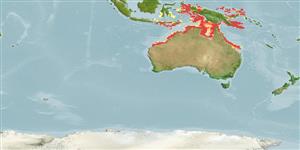分类 / Names
俗名 | 同种异名 | Catalog of Fishes(属, 种) | ITIS | CoL | WoRMS | Cloffa
Elasmobranchii
板鳃亚纲 (鲨鱼与 鱼) (sharks and rays) >
Orectolobiformes (Carpet sharks) >
Orectolobidae (Carpet or nurse sharks)
Etymology: Eucrossorhinus: eu (Gr.), very; Crossorhinus (=Orectolobus), previous genus, from krossos (Gr.), fringe or tassel, referring to tassel of dermal lobes fringing the head, and rhinus, an ancient name for sharks, from rhine (Gr.), rasp, alluding to their rasp-like skin, or rhinos, snout, referring to “lobe-like attachments from the nose” (translation, from Müller & Henle’s 1837 description of Crossorhinus) (See ETYFish); dasypogon: dasys (Gr.), hairy; pogon (Gr.), beard, referring to dense beard-like tassel of dermal lobes fringing the head (See ETYFish).
More on author: Bleeker.
Environment: milieu / climate zone / depth range / distribution range
生态学
海洋 礁区鱼类; 深度上下限 2 - 50 m (Ref. 106604). 深水域; 1°N - 23°S, 115°E - 155°E
Indo-West Pacific: eastern Indonesia, Papua New Guinea, and northern Australia (including Barrow Island, Western Australia). Questionable occurrence in Malaysia.
西太平洋: 印度尼西亚东部,巴布亚新几内亚与澳洲北部 (包括澳洲西部的 Barrow 岛). 在马来西亚的可疑发生。
大小 / 重量 / 年龄
Maturity: Lm ? range ? - ? cm
Max length : 366 cm TL 雄鱼/尚未辨别雌雄; (Ref. 90102); common length : 180 cm TL 雄鱼/尚未辨别雌雄; (Ref. 90102)
背棘 (总数) : 0; 臀棘: 0. Body with a reticular pattern of narrow dark lines (Ref. 13577). Caudal fin with its upper lobe hardly elevated above the body axis, with a strong terminal lobe and subterminal notch but no ventral lobe (Ref. 13577).
身体有一个狭窄黑色线条的网状图案.(参考文献 13577) 尾鳍上叶并不高的上方体轴, 具有一个强韧的端叶与接近端位的凹槽但是没有腹的叶.(参考文献 13577)
A little-known shark (Ref. 247) found on the continental shelf and offshore reefs (Ref. 6871). Probably feeds on bottom fishes and invertebrates (Ref. 13577, 43278); also known to eat nocturnal teleost fishes such as squirrelfish and soldierfish (Holocentridae) and sweepers (Pempheridae) (Ref. 43278). Ovoviviparous (Ref. 50449). Might bite in self-defense or when mistaking a human foot for its usual prey (Ref. 247). Its tough skin sometimes used for leather (Ref. 13577). The maximum length of 366 cm TL reported for this species is uncertain (Ref. 247, 90102).
所知极少的鲨鱼 (参考文献 247) 发现于大陆架与外海礁石了。 (参考文献 6871) 可能吃底层鱼类与无脊椎动物。 (参考文献 13577) 卵胎生的.(参考文献 50449) 可能在自我防卫中咬或当误以为人类的脚是它的平常猎物的时候.(参考文献 247) 它的硬皮有时作为皮革.(参考文献 13577) 366 公分TL 的最大长度这个种的报告不确定.(参考文献 247)
Life cycle and mating behavior
成熟度 | 繁殖 | 产卵场 | 卵 | 孕卵数 | 仔鱼
Ovoviviparous, embryos feed solely on yolk (Ref. 50449).西太平洋: 印度尼西亚东部,巴布亚新几内亚与澳洲北部 (包括澳洲西部的 Barrow 岛). 在马来西亚的可疑发生。
Compagno, L.J.V., 1984. FAO Species Catalogue. Vol. 4. Sharks of the world. An annotated and illustrated catalogue of shark species known to date. Part 1 - Hexanchiformes to Lamniformes. FAO Fish. Synop. 125(4/1):1-249. Rome, FAO. (Ref. 247)
世界自然保护联盟红皮书 (Ref. 130435: Version 2024-1)
人类利用
渔业:
工具
特别资料
下载 XML
网络资源
Estimates based on models
Preferred temperature (Ref.
123201): 26.2 - 28.8, mean 27.8 °C (based on 294 cells).
Phylogenetic diversity index (Ref.
82804): PD
50 = 1.0002 [Uniqueness, from 0.5 = low to 2.0 = high].
Bayesian length-weight: a=0.00389 (0.00180 - 0.00842), b=3.12 (2.94 - 3.30), in cm total length, based on all LWR estimates for this body shape (Ref.
93245).
营养阶层 (Ref.
69278): 4.0 ±0.60 se; based on food items.
回复力 (Ref.
120179): 低的, 最小族群倍增时间4.5 - 14 年 (Fec assumed to be <100).
Fishing Vulnerability (Ref.
59153): Very high vulnerability (90 of 100).
Nutrients (Ref.
124155): Calcium = 1.57 [0.18, 7.23] mg/100g; Iron = 0.125 [0.027, 0.423] mg/100g; Protein = 19.4 [17.1, 21.6] %; Omega3 = 0.0936 [, ] g/100g; Selenium = 7.92 [2.19, 30.75] μg/100g; VitaminA = 13.4 [2.3, 84.0] μg/100g; Zinc = 0.248 [0.114, 0.523] mg/100g (wet weight);
